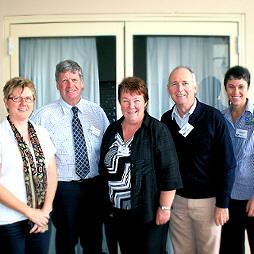Posted 10 March 2011

Attendees (L to R): Wendy Timms - UNSW Water Research Lab, Jim MacDonald - Namoi CMA Chair, Narrabri Mayor Robyn Faber, Tony Jakeman - ANU NCGRT, Cotton CRC Forum organiser Jane Macfarlane
The success of the recent Namoi Groundwater Forum 2010 illustrates the importance of groundwater to the environment and economy of the Namoi valley and the significance of this research for management and use of this vital resource.
Convened by the Cotton Catchment Communities CRC and Namoi Catchment Management Authority on 3 December, 2010 in Tamworth, New South Wales, the event was very well attended, attracting more than 40 participants, including local Mayors, representatives from mining and gas companies, Murray Darling Basin Authority, Namoi Catchment Management Authority, NSW Office of Water, Local Governments, National Water Commission, Namoi Water, University of New South Wales and the Australian National University.
Attendees came to the event to gain a clearer understanding of current groundwater issues and research, strategic directions in groundwater management and future trends. Leading researchers presented the latest knowledge of groundwater in the Namoi.
One of the key messages of the day was that flooding is the main mechanism of recharge to groundwater, highlighting the importance of the investigation of surface and groundwater connectivity. The potential for managing aquifer recharge was one of the newest approaches discussed on the day.
The event also explored the opportunities for collaborative approaches including agriculture, mining, coal seam gas and environmental managers for the use and management of groundwater and attendees were encouraged by the feeling of future collaboration.
To move towards a more integrated approach to groundwater investigation including the role of agriculture, gas and mining in affecting groundwater dynamics and quality, one of the outcomes of the day was to form a Research and Development working group including all relevant parties in the Valley.
Working together should develop a better shared vision or views on long term expectations of the valley. The Cotton CRC will work with the Namoi CMA to progress this early in 2011.
Cotton Catchment Communities CRC and Namoi Catchment Management Authority thanks all participants for contributing to the success of the event.
Source: Cotton Catchments Community CRC web site
Links:

Professor Andy Baker features in American Water Resources Association ‘Water Resources Impact’, September 2020 edition.

The Connected Waters Initiative (CWI) is pleased to welcome Taylor Coyne to its network as a postgraduate researcher. If you’re engaged in research at a postgraduate level, and you’re interested in joining the CWI network, get in touch! The CWI network includes multidisciplinary researchers across the Schools of Engineering, Sciences, Humanities and Languages and Law.

The Grand Challenge on Rapid Urbanisation will establish Think Deep Australia, led by Dr Marilu Melo Zurita, to explore how we can use our urban underground spaces for community benefit.

On the 21 August 2020, CWI researchers made a submission to the National Water Reform Inquiry, identifying priority areas and making a number of recommendations as to how to achieve a sustainable groundwater future for Australia.

Results published from a research project between the Land Development Department (LDD) Thailand and UNSW has demonstrated how 2-dimensional mapping can be used to understand soil salinity adjacent to a earthen canal in north east Thailand (Khongnawang et al. 2020).